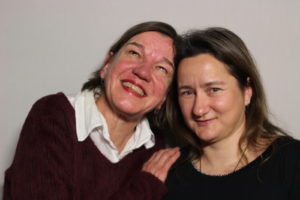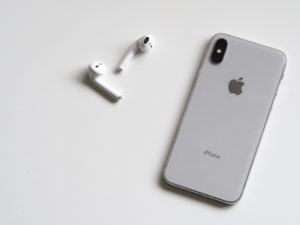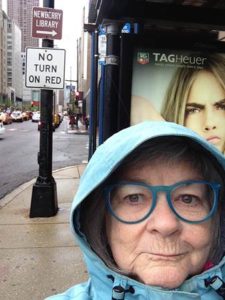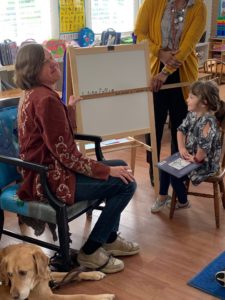Benefits of Teaching Memoir: Sharing Voices for Generations to Come
January 19, 2019 • 12 Comments • Posted in careers/jobs for people who are blind, guest blog, memoir writing, radio, teaching memoir
That’s me and Iliana. Photo courtesy Storycorps.
I am pleased to introduce Iliana Genkova as a guest blogger today. Born and raised in Bulgaria, Iliana completed a degree in the sciences there and came to America to work with weather satellites. From there she went on to live and work around the world — UK, the Netherlands, Australia— before settling in Chicago, where she now works full-time as an Atmospheric Scientist with the National Oceanic and Atmospheric Administration (NOAA). The recent government furlough allowed her to sign up for one of my memoir-writing classes and do a StoryCorps interview with me earlier this month. I have interviewed three different people for StoryCorps, but this was the first time someone interviewed me. Sitting on the other side of the desk was challenging –- I wanted to ask all the questions! I’ll Let Iliana explain…
42 minutes with Beth
by Iliana genkova
The first time I stumbled upon StoryCorps I was meandering through the Chicago Cultural Center. I was drawn by their bright red, cursive sign. After listening to a couple of stories about love and forgiveness, I left the place charged with hope. I was reassured that despite our differences and how diverse our lives are, we all want the same: to be loved, accepted, and understood.
Since then, every time I pass by the Chicago Cultural Center I would try to think of someone I know that has a story worthy of sharing with StoryCorps. In anticipation of taking a memoir writing class with Beth Finke, I read her memoir Writing out loud. A few chapters in, the light bulb in my head went off. What a spirit she is; she would be a great StoryCorps guest. Luckily, she agreed to be interviewed.
I really wanted to do this. I worked diligently on thinking up good questions for the interview. I ran them by a teacher I had for an interview class. Yet, there I was on the day of the interview, nervous, questioning if I was right for this.
When Beth arrived to StoryCorps we first had to fill out some paperwork. I offered to help. The last question on the form, “How would you describe yourself in a sentence or two,” was a perfect segue to our interview.
The recording studio is in essence a wooden cube with a three-yard long side. Stepping in felt like jumping in at the deep end. Once in, however, it’s dimly lit, incredibly quiet ambiance gave a sense of intimacy and safety. I began asking questions in the order I had them written down. But interviews do not always follow order. I skipped, returned to, and improvised questions.
I’ve been taught to be an active listener, to nod occasionally, keep eye contact, smile and use facial expressions, but Beth wouldn’t see that. I’d like to encourage the speaker with verbal comments like ‘yes’ and ‘uh huh’, but the StoryCorps facilitator warned us the microphones are very sensitive so when one of us speaks the other must be quiet. I was struggling to adhere to the rules.
I reached the more personal questions. After hearing the first one Beth paused, adjusted in her chair, looked right at me and responded with honesty. I could see this was emotionally taxing for her. This was exactly the bravery that I was hoping to hear about, the strength to deal with life’s unfairness, the resilience in the face of adversity. The life experience gets relived briefly, the feelings from the past may resurface for a moment, but the story of the human spirit’s strength is told. It’s stories like this that inspire and encourage us.
It was an honor to interview Beth for StoryCorps. I doubt the 42 minutes we had in the recording booth would do Beth’s story justice, but I’d like to believe I gave it a chance to be heard by sharing some of her experience, highlighting her incredible ability to take things lightly, and proving that attitude and humor make life a bit easier.
I hope the interview piques the listeners’ curiosity and they read her books, take her memoir writing class, and maybe, hopefully, make Beth’s dream — to teach her Memoir Teacher Masterclass around the world — come true. I, personally got to know Beth better and that is something to cherish.
StoryCorps’ mission is to preserve and share humanity’s stories in order to build connections between people and create a more just and compassionate world. People of all backgrounds can record meaningful conversations, just sign up with one of the StoryCorps recording sites. That page also explains ways you can donate to help StoryCorps record, share and preserve these voices for generations to come.



